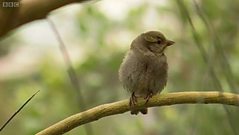
Moulting gold
Swan feathers have many uses, and not just for the swan.
Chris Packham feeds the mute swans at Abbotsford Swannery in Dorset. There are nearly 1,000 swans at this breeding colony and it is open to the public. At eight miles long, the Fleet Lagoon is the largest tidal lagoon in the UK. The swannery is at its western end. You can probably remember from your youth all those stories about swans being able to break your arm. Dave Wheeler, Britain's only swan-herd, says that's possible, but it is only nesting birds in their territory that are aggressive. They will chase off a threat. However, the Abbotsford swans are used to people, so visitors can stand at the edge of a nest while the eggs hatch. It's a unique situation. The lagoon is shallow with lots of natural food and it has supported a colony of swans for at least 650 years. The colony has been in the hands of the same family since Henry VIII dissolved the monasteries. Before that they were looked after by the local Benedictine monks, who realised that swans were a good resource and if they managed it there would be more swans for the table. These days we don't eat swans, but the moulted feathers are collected and sold for calligraphy quills. A right handed calligrapher needs a quill from the left wing of the bird. Other uses for the feathers are in making beekeeper's brushes, artificial marble and applying gold leaf. In mid-summer the swans begin their annual moult and are vulnerable because they can't fly - so they gather together as they shed their feathers. Why do they bother? Their feathers get tatty and are not as efficient in flight. They only last about 12 to 18 months so it is essential they are replaced. Evolution has a clever strategy for this - the females moult first and the males hang on to their feathers for longer, so that they can defend the youngsters. Those feathers are even used on the headdresses of the Gentlemen-at-Arms - the Queen's bodyguard.
Duration:
This clip is from
Featured in...
![]()
Βι¶ΉΤΌΕΔ Nature
Be captivated, informed and inspired by the world's wildlife.
More clips from Summer: Rivers, Lakes and Lochs
-
![]()
Clinging on
Duration: 02:05
-
![]()
Vole venture
Duration: 02:34
-
![]()
River of gold
Duration: 02:26
-
![]()
Swarm at rest
Duration: 00:40
More clips from Nature's Calendar
-
![]()
Bizarre behaviour—Series 1, Summer: Parks and Gardens
Duration: 01:27
-
![]()
Hot-housing sparrows—Series 1, Summer: Parks and Gardens
Duration: 01:42
-
![]()
Long-legged lovelies—Series 1, Summer: Wetland
Duration: 02:38
-
![]()
Young grass snake—Series 1, Summer: Parks and Gardens
Duration: 01:30










